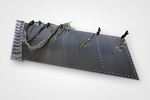Continuous Composites, Aurora Flight Sciences advance launched effect structures
Under an awarded U.S. Army SBIR, this initiative will reimagine the internal architecture of fuselage structures for launch effects, aided through CCI’s CF3D tech.
Source | Continuous Composites
On June 9, Continuous Composites (CCI, Coeur D’Alene, Idaho, U.S.) was awarded a U.S. Army Small Business Innovation Research (SBIR) project in collaboration with Aurora Flight Sciences (Bridgeport, Va., U.S.), a Boeing company, to develop next-generation fuselage structures for launched effects. The project, which originated as a Navy-funded initiative, was successfully transitioned to the Army following the completion of Phase One and is now entering Phase Two with a $2 million contract.
The initiative focuses on enhancing the structural integrity of systems designed to be launched from canisters — similar to missile deployment systems — and aims to set new performance benchmarks for these air-launched platforms. Aurora is providing critical flight load data and geometric designs, which Continuous Composites will use to develop optimized fuselage structures through its patented CF3D technology.
Leveraging its expertise in fiber steering and topology optimization, CCI will engineer lightweight, high-performance fuselage designs that maximize internal volume, directly increasing payload capacity without compromising overall performance. This approach reimagines internal architecture, using less material while embedding greater strength into the design, reducing weight and improving efficiency for mission-critical aerospace applications.
“This collaboration represents a convergence of aerospace innovation and cutting-edge manufacturing technology,” says Steve Starner, CEO of CCI. The SBIR contract marks a pivotal step in scaling CF3D for high-performance defense applications, positioning CCI as a strategic supplier of lightweight, rapidly deployable aerospace solutions to the Department of Defense. This funding validates the potential of CF3D to revolutionize structural components for launched effects and other aerospace technologies.
Related Content
-
“Structured air” TPS safeguards composite structures
Powered by an 85% air/15% pure polyimide aerogel, Blueshift’s novel material system protects structures during transient thermal events from -200°C to beyond 2400°C for rockets, battery boxes and more.
-
Orbital Composites wins AFWERX award for Starfighter drone fleet
Under the TACFI contract, Orbital is implementing the AMCM process to build 3D printed composite multi-mission UAS aircraft, surpassing $10 million in government awards.
-
Scaled Composites Model 437 aircraft to be flown for Beacon autonomy testbed
Northrop Grumman subsidiary part of Digital Pathfinder development of stealth aircraft with wings using continuous carbon fiber additive manufacturing and determinate assembly.



